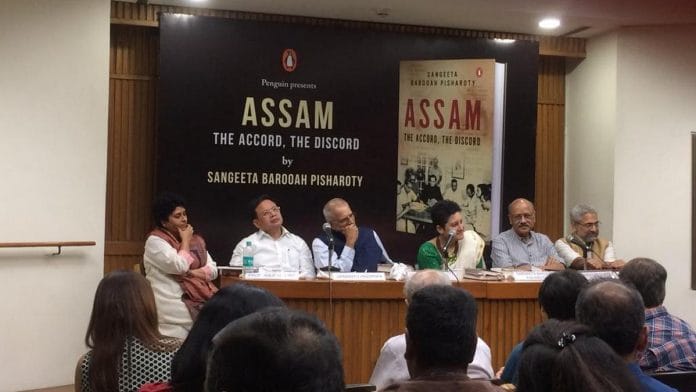New Delhi: At the launch of Sangeeta Barooah Pisharoty’s book ‘Assam, The Accord, The Discord’ in New Delhi Wednesday, the buzz was all about how it was a timely piece in more ways than one.
The book traces the National Register of Citizens (NRC) to its genesis — the Assam Accord signed between former prime minister Rajiv Gandhi, All Assam Students Union and the state government on 15 August 1985 — the surge of Asom Gana Parishad government, the rise of United Liberation Front of Assam, the 15 years of Congress rule and the BJP’s huge victory in the state in 2016.
The final NRC list to weed out “illegal immigrants” in Assam was published only about a fortnight ago. The list excluded over 19 lakh people — propelling the state once again into a vortex of chaos and exposing its decades-old ethnic faultlines.
Discussing the book were former home secretary G.K. Pillai, Editor-in-Chief of ThePrint Shekhar Gupta, founding editor of The Wire Siddharth Varadarajan, professor at the Centre for Political Studies in JNU Anupama Roy and senior Supreme Court advocate Upamanyu Hazarika.
“This is the first book on NRC by a mainstream publishing house after the Assam Accord was published over 30 years ago. I wanted to look back on what we have lost and gained in all these years,” said Pisharoty while explaining what had prompted her to write the book in the first place.
The author, who was born in Assam’s Golaghat, said she had to leave her home state for Delhi in search of better opportunities in the years after the accord was signed in 1985.
Also read: Assam wanted an end to its ethnic conflict. In the end, it got an NRC that nobody accepts
The book
Pisharoty says in her book that the BJP’s bid to protect non-Muslim immigrants through the Citizenship (Amendment) Bill has undermined the agnostic nature of the anti-foreigner sentiment among the Assamese. She also details the long-held grouses of the Assamese against the Bengali population in the state.
Three out of the four panellists, including Gupta, Pillai and Varadarajan, agreed that the solution lies not in publishing an NRC list, while Hazarika believed it was necessary in order to protect the indigenous communities of the state.
Who is an indigenous?
The discussion began with one of the most brutal memories in Assam and an outcome of a dispute between ‘indigenous tribals’ and ‘immigrants’ — the Nellie massacre of 1983.
Gupta, who had extensively covered the violence, said, “As an outsider in the state at the time, there was always this confusion if it was an ethnic or a communal incident.”
He later added how there has been an inadequate understanding about the compulsions of economic migration to the state.
Varadarajan argued that “economic migrants” should not be called “illegal infiltrators” as it not only corrodes the term but also adds a certain connotation to it.
Roy also agreed that the term ‘illegal immigrant’ in the Citizenship Bill has “complicated matters”. She further said how documenting has, in fact, enabled illegal migrants to become citizens.
Giving examples of Assam’s multicultural character, Hazarika, on the other hand, said national and international media had only focussed on the purported violation of human rights and not on the “real reasons behind having an NRC”.
Also read: 15 August is special for Assam and it’s not just about Independence Day
Explaining how immigrants have “encroached” on several hectares of land in the state, forcing indigenous communities into smaller ghettoes, Hazarika stressed on the need to protect cultural and political rights of the khilonjiya (indigenous) Assamese.
The debate on “who is an indigenous” took an interesting turn when Gupta said that the essential problem still remains as it was in 1979 — if the concerns in Assam are indigenous or Indian. And if it is indigenous, the Constitution can but help little, Gupta said.
Pillai added to it and said how there has been no consensus on who is an indigenous. “There has been no political consensus on the issue. There were talks earlier about giving work permits too but no agreement has been reached on that front either. L.K. Advani, as a home minister in the NDA government, was totally opposed to it.”
Hazarika said “disincentivising” immigrants can be a solution, but Gupta argued against it.
Also read: Stung by final NRC outcome, BJP readies new on-ground strategy for Assam







The Assam Accord was signed six years before the opening up of the economy. India has grown and developed so much since then. The people of Assam and the rest of the north east can participate in these opportunities, instead of remaining rooted in the past. 2. If an Inner Line Permit is required to visit Nagaland, Mizoram, Arunachal Pradesh, starting with tourism, all of economic growth will be impacted. State governments will need virtually all of their fiscal resources to come from Delhi – which actually means South Bombay …